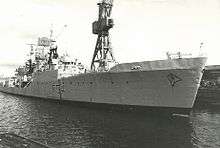HMS Hardy (F54)
.jpg) HMS Hardy (F54), 14 July 1969 (IWM HU 129855) | |
| History | |
|---|---|
| Name: | HMS Hardy |
| Namesake: | Thomas Masterman Hardy |
| Builder: | Yarrow Shipbuilders |
| Laid down: | 4 February 1953 |
| Launched: | 25 November 1953 |
| Acquired: | 8 December 1955 |
| Commissioned: | 15 December 1955 |
| Identification: | Pennant number: F54 |
| Fate: | Sunk as target 3 July 1984 |
| General characteristics | |
| Class and type: | Blackwood-class frigate |
HMS Hardy was an anti-submarine warfare frigate of the Blackwood class or Type 14. She was named after Thomas Masterman Hardy, Captain of HMS Victory at Trafalgar. Hardy was the first Type 14 frigate built, completed on 8 December 1955, by Yarrow Shipbuilders.
Operational Service
On commissioning Hardy served in the Third Training Squadron at Londonderry Port before transferring to the Second Training Squadron in Portland in 1957. In 1960 she underwent a major modernisation and refit, before joining the Twentieth Frigate Squadron in Londonderry Port.[1] In 1967 Hardy transferred to the Second Frigate Squadron and attended Portsmouth Navy Days.[2] The after 40 mm guns in these ships were removed early in their careers due to hull strengthening problems.
Icelandic Patrol and the First Cod War.
Hardy had a single screw (propeller) around which the ship would rotate in the slightest weather. The freeboard aft of the upper deck super structure was a mere 7 feet. Conditions on board were harsh, mountainous seas, frequent gales, cold and Icelandic gunboats a regular feature; they were very good sailors. Fortunately our skipper, Lt Cdr Melly, was more than a match for them. In any sort of weather above Force 4 the area aft of the upper deck super structure was frequently awash and whilst in Icelandic waters life lines were a permanent feature to allow safe access to the after mess desk, where the stokers and ERAs lived. Food was collected from the galley and taken to the mess in "billy cans". On many occasions the food was swept away by a wave whilst the lifeline kept the rating safe, if soaked. Eventually the Admiralty accepted conditions were abnormal and paid "Hard Layers" money to those living in the after mess deck. On the plus side trawlermen were generous with a steady supply of fresh fish being transferred when weather permitted. Rest breaks were in Londonderry, where the ratio of women to men was 7:1, of more interest to the crew than the increasing IRA activity and Quartermasters being issued live ammunition, a very rare occurrence in peace time.
Serving mainly in the Londonderry Port and Portland areas, Hardy attended the 1977 Silver Jubilee Fleet Review off Spithead when she was part of the 2nd Frigate Squadron.[3]

She paid off to the Standby Squadron in August 1977, then, after another short spell of operational service at Portland, became a stores accommodation ship in Portsmouth in October 1979. She was used as a target for Exocet missiles and was finally sunk, by torpedo, in the Western Approaches 3 July 1984.
Commanding Officers
| From | To | Captain |
|---|---|---|
| 1960 | 1962 | Lieutenant Commander W Melly RN |
| 1965 | 1966 | Lieutenant Commander N Bearn RN |
| 1966 | 1967 | Lieutenant Commander J T Lord RN |
| 1973? | 1975? | Lieutenant Commander M Jones RN |
| 1977 | 1977 | Lieutenant Commander M J Larmuth RN |
References
Publications
- Colledge, J. J.; Warlow, Ben (2006) [1969]. Ships of the Royal Navy: The Complete Record of all Fighting Ships of the Royal Navy (Rev. ed.). London: Chatham Publishing. ISBN 978-1-86176-281-8. OCLC 67375475.
- Marriott, Leo (1983). Royal Navy Frigates 1945-1983. Ian Allen Ltd. ISBN 07110 1322 5.